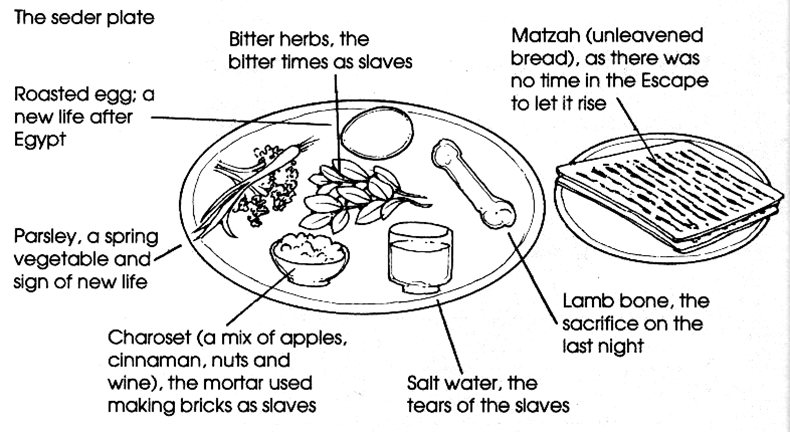Seder Plate

Nothing on the Seder table is selected randomly; each item has it’s purpose and often it’s specific place. The Seder plate holds at least six of the ritual items that are discussed during the Seder: the shankbone, maror, charoset, karpas, salt water, orange, roasted egg, and boiled egg.
ROASTED SHANKBONE
One of the most striking symbols of Passover is the roasted lamb shankbone (called zeroah), which commemorates the paschal (lamb) sacrifice made the night the ancient Hebrews fled Egypt. Some say it symbolizes the outstretched arm of God (the Hebrew word zeroah can mean “arm”). Many vegetarians use a roasted beet instead. This isn’t a new idea; the great Biblical commentator Rashi suggested it back in the eleventh century.
MAROR (BITTER HERB)
Bitter herbs (usually horseradish) bring tears to the eyes and recall the bitterness of slavery. The Seder refers to the slavery in Egypt, but people are called to look at their own bitter enslavements.
CHAROSET
There’s nothing further from maror than charoset (“cha-ROH-set”), the sweet salad of apples, nuts, wine, and cinnamon that represents the mortar used by the Hebrew slaves to make bricks.
KARPAS
Karpas is a green vegetable, usually parsley (though any spring green will do). Karpas symbolizes the freshness of spring. Some families still use boiled potatoes for karpas, continuing a tradition from Eastern Europe where it was difficult to obtain fresh green vegetables.
SALT WATER
Salt water symbolizes the tears and sweat of enslavement, though paradoxically, it’s also a symbol for purity, springtime, and the sea.
ORANGE
The tradition of putting an orange on the seder plate has a highly contested story, but what we've found the most accurate is:
In the early 1980s, while speaking at Oberlin College Hillel, Susannah Heschel, a well-known Jewish feminist scholar, was introduced to an early feminist Haggadah that suggested adding a crust of bread on the seder plate, as a sign of solidarity with Jewish lesbians (which was intended to convey the idea that there's as much room for a lesbian in Judaism as there is for a crust of bread on the seder plate). Heschel felt that to put bread on the seder plate would be to accept that Jewish lesbians and gay men violate Judaism like hametz [leavened food] violates Passover. So at her next seder, she chose an orange as a symbol of inclusion of gays and lesbians and others who are marginalized within the Jewish community. The orange is now said to be a symbol of the fruitfulness of all Jews, regardless of sexual orientation or gender.
ROASTED EGG
The roasted egg (baytsah) is a symbol in many different cultures, usually signifying springtime and renewal. Here it stands in place of one of the sacrificial offerings which was performed in the days of the Second Temple. Another popular interpretation is that the egg is like the Jewish people: the hotter you make it for them, the tougher they get.
BOILED EGG (TO EAT)
May we reflect on our lives this year and soften our hearts to those around us. Another year has passed since we gathered at the Seder table and we are once again reminded that life is fleeting. We are reminded to use each precious moment wisely so that no day will pass without bringing us closer to some worthy achievement as we all take a moment to be aware of how truly blessed we are.
Our faith gives us many holidays to celebrate throughout the year and they are all times for self reflection, gently guiding us to a better path in life. We are each given a chance to reflect on our past year; to think about where we have been and how we will live our lives in the year to come. We reaffirm our commitment to lead good and meaningful lives, promoting peace wherever we go.
Inspired to create
your own Haggadah?
Make your own Haggadah and share with other Seder lovers around the world
Have an idea
for a clip?
People like you bring their creativity to Haggadot.com when they share their ideas in a clip
Support Us
with your donation
Help us build moments of meaning and connection through
home-based Jewish rituals.
OUR TOP CONTRIBUTORS
Passover Guide
Hosting your first Passover Seder? Not sure what food to serve? Curious to
know more about the holiday? Explore our Passover 101 Guide for answers
to all of your questions.






















